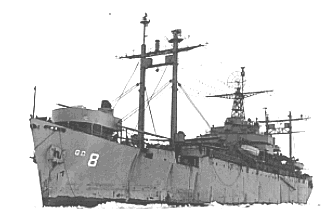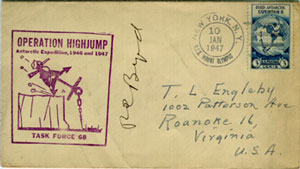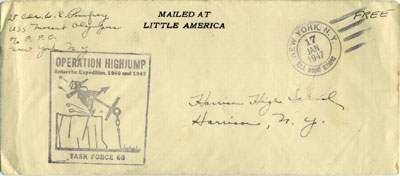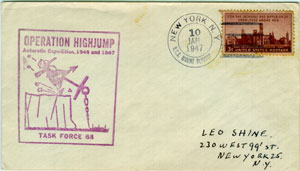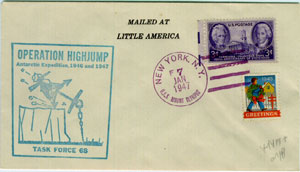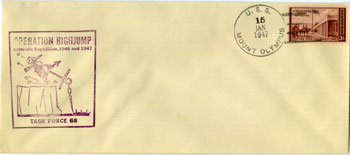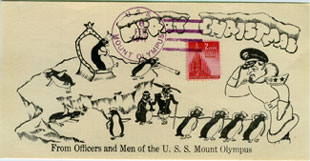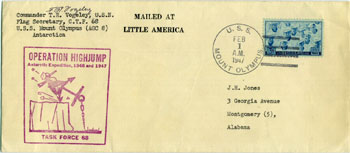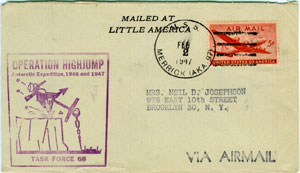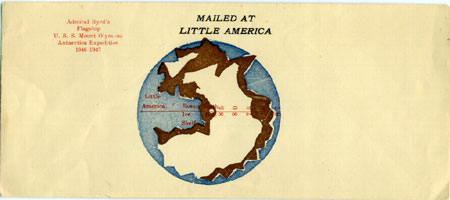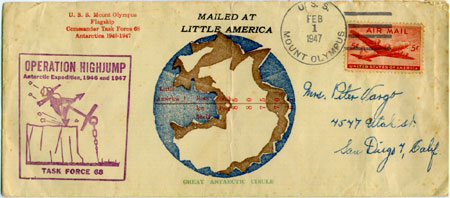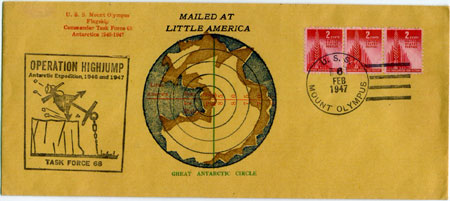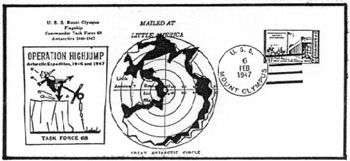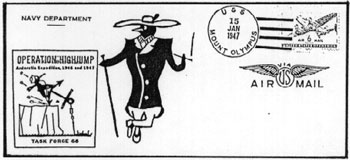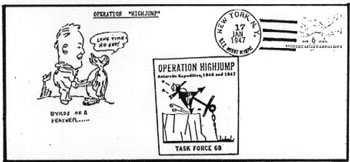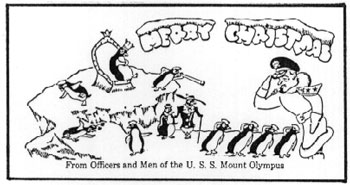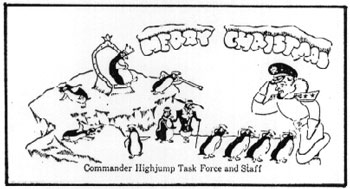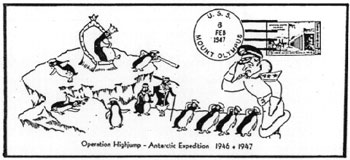|
Although dated January 10, the postmarking of philatelic mail actually commenced long before that date. January 10th was selected as a proper date for the postmark because it was assumed that the USS MOUNT OLYMPUS would be at Little America by then.
As a matter of fact, USS MOUNT OLYMPUS was still fighting her way through the heavy pack ice of the Ross Sea with the other ships of the Central Group on January 10. Actual application of postmarks and cachets commenced on January 3, but it was not until mid-month that the task was completed. Given the large volume of covers to be handled, it is surprising to note that the great majority have neatly applied postmarks and clear cachet impressions. Upon completion of this substantial undertaking, the philatelic mail was transferred to the USCGC NORTHWIND which departed the Bay of Whales on January 20. The USCGC NORTHWIND transferred the mail to the USS PHILIPPINE SEA which in turn carried the covers to the Canal Zone. There they were deposited at Balboa for onward transmission to their addressees on February 18. A multitude of postmark types and varieties are to be found on USS MOUNT OLYMPUS mail. Four main types and several minor varieties can be readily identified and further types may be reported. The bulk of the philatelic mail serviced on board during the expedition received the Type 1 postmark. It was at first thought that only the January 10, 1947 date appeared in this type of cancellation. However, it is now known that other dates do exist which include December 10, 1946 and January 7, 1947. At an early stage of the operation, the postmarking device became damaged, resulting in a portion of the outer circle becoming dislodged. The undamaged postmark (Type 1b) is relatively scarce on cover, as are impressions of the postmark which show the partially dislodged portion of the outer circle still adhering to the device (Type 1a). January mail posted on board by the ship's crew generally bears the Type 2 postmark, while little mail sent to the ship by philatelists received this marking. Dates recorded for the Type 2 postmark include January 7, 11, 14, 15 and 17. While it is difficult to say with certainty that varieties of this postmark type exist, minor differences do show up on different covers. Further research into these varieties would be beneficial, but it is believed that these varieties are the result of the manner in which the hand stamp was applied to the envelope, varying degrees of inking pressure, etc. Sometimes there is no punctuation, sometimes a triangular comma, and sometimes a square period. Killer bar length seems to be about 25mm from the top bar in nearly all examples of the Type 2. In mid-December, USS MOUNT OLYMPUS was informed by radio that a large volume of philatelic mail had reached the Fleet Post Office in New York after the December deadline for such a request, and that these additional covers would be coming south on the USS PHILIPPINE SEA. Not knowing how many more covers were included in this dispatch, an additional six HIGHJUMP cachets and six USS MOUNT OLYMPUS postmarks were requisitioned from the States. The postmarks, along with the additional sacks of philatelic mail, were received by USS MOUNT OLYMPUS on January 30, 1947. The new postmark turned out to be the Type 3 variety shown, and the roughly 10,000 covers received with the late mail were postmarked with the Type 3, dated February 1 and 2. Although six postmark devices were received, no varieties have been noted with the exception of missing A.M. or P.M. slugs. Confusing the issue somewhat are covers with Type 3 postmarks dated in early mid-January 1947. These are either intentionally backdated items, or else error cancels in which the incorrect month slug was inserted. In addition to philatelic usage, the Type 3 postmarks became the standard cancel for the mail of the ship's complement, replacing the previously used Type 1 and Type 2 date stamps. The most uncommon postmark type from the USS MOUNT OLYMPUS during this period is the double circle Type 4 general purpose postmark without killer bars, and with BR. (Branch) after "Mount Olympus". Postmarks of this type are generally used to backstamp registered mail, on money orders and receipts, etc., and in the case of USS MOUNT OLYMPUS, a few have been reported used on HIGHJUMP covers. One example is known used on a personal telegram draft prepared by Admiral Byrd. No covers have been recorded bearing any sort of ship's name or return address hand stamp from the USS MOUNT OLYMPUS, which makes for an unusual situation. One cover has been seen with the Type 1 cachet MAILED AT / LITTLE AMERICA rubber stamp in violet. Its origin is uncertain. Also of uncertain origin, but probably used by one of the postal clerks on the ship, is the Type 2 pictorial cachet depicting a penguin dragging a mail bag. A total of 42 mailbags of philatelic request were delivered to the USS MOUNT OLYMPUS prior to her departure from Norfolk, VA on December 2, 1947. Covers were submitted for addresses in 125 different countries, including such places as North Borneo, Saudi Arabia and El Salvador. While estimates of the total number of philatelic covers serviced by USS MOUNT OLYMPUS during HIGHJUMP vary considerably, the most reliable estimate is a total of approximately 150,000, the majority of this (140,000) being serviced with the 10 January 1947, Type 1 postmark and most of the remainder with the Type 3. This ranks USS MOUNT OLYMPUS covers from the expedition as perhaps the second most common polar cover in existence (the all-time champ being the December 15, 1956, Pole Station, Antarctica "first day covers"). In contrast to the proliferation of mail from the USS MOUNT OLYMPUS, mail from other ships is relatively scarce and, in the case of certain ships, extremely elusive. Additionally, philatelic mail from many of these ships is most often found with March and April dates in the postmark, long after they departed Antarctic waters.
Mount Olympus Special LITTLE AMERICA Cachets On board Mount Olympus was a printing office which was provided with professional printing equipment. In addition to handling normal printing chores, such as publishing official orders, the ship's newspapers, BERGY BITS and the PENGUIN PRESS, and printing shellback certificates, the print shop crew accepted requisitions for specially designed envelopes commemorating HIGHJUMP. Virtually the only requirement was that the requisition be signed by an officer; upon meeting that requirement, crew members could have envelopes printed for their personal use. That these specially printed envelopes were popular items is evidenced by a report in the January 11, 1947, issue of BERGY BITS stating that 15,986 "Antarctic envelopes" had been run off the ship's press as of that date. Despite this high figure, which certainly was even higher by the end of the expedition, these printed envelopes are elusive items today. In general, the printed envelopes are found with Mount Olympus postmarks, but occasionally they will bear the postmark of one of the other Central Group ships. A majority of the envelopes printed on board Mount Olympus bear the black imprints, "MAILED AT LITTLE AMERICA" in two lines. Five varieties of this inscription, referred to henceforth as a "MALA block," are recorded. Envelopes bearing solely one of the MALA blocks are found in a variety of sizes, from #6¾ to #10, including plain white, airmail, and Navy Department Official Business envelopes.
TYPE A
TYPE B
(Note:
Types A & B are very similar; they can best be differentiated by using
TYPE D
TYPE E
Mount Olympus Printed Covers
ENVELOPE TYPE I One run of envelopes was printed with the inscription "U.S.S. MOUNT OLYMPUS / FLAG (2-star flag) SHIP" in black in combination with the Type C MALA block. The two-star flag, of course, is that of a Rear Admiral, in this case RADM Cruzen, the Task Force 68 Commander. Type 1 envelopes are #10 size, plain white or manilla paper.
ENVELOPE TYPE 2 Perhaps the most attractive covers produced on board are the multicolored Antarctic map series.These were printed using two handcarved linoleum blocks to produce the map and standard type for the inscriptions. The large map was generally placed in the middle of a #9 or #10 envelope to leave room at the left for the standard HIGHJUMP rubber stamp cachet. Distinct varieties of these envelopes exist as a result of separate printing runs. Type 2 was the initial printing of this series, the red corner card reading, "Admiral Byrd's / Flagship / U.S.S. Mount Olympus / Antarctica Expedition / 1946-1947." The printing on the map (place names, horizontal line and degrees of latitude) also appears in red, while the Type B MALA block is printed in black. The map itself is printed in blue (water areas) and brown (portions of the Antarctic continent), leaving the interior of the continent appropriately white. Size 9 plain white envelopes seem to have been exclusively used for this printing run. Upon seeing these envelopes, Admiral Byrd expressed his displeasure with the wording, "Admiral Byrd's Flagship," this being technically incorrect and personally embarrassing to the Admiral. He ordered their use discontinued, and further distribution was immediately halted.
ENVELOPE TYPE 3 A revised edition of the map envelope, Type 3, was released shortly thereafter, bearing a corner card which had the Admiral's approval: "U.S.S. Mount Olympus / Flagship / Commander Task Force 68 / Antarctica 1946-1947." This inscription, the horizontal line across the map, the latitudinal coordinates, and "Little America," "Ross Ice Shelf," and "South Pole" appeared in red as was the case with Type 2. Likewise, the map appeared in the same colors as previously. However, further color was added to the envelopes by including a vertical line across the map and the inscription, "GREAT ANTARCTIC CIRCLE," both in green. Type 3 envelopes are found with Types A, B and C MALA blocks and were printed on #9 and #10 plain white envelopes as well as Navy Department Official Business #10 airmail envelopes. Occasionally these covers will be found with concentric circles of latitude on the map; such circles were not printed thereon and close examination will reveal they were applied with pen and ink on an individual basis (Type 3a) and as thus, are very rare.
ENVELOPE TYPE 4 Accompanying the expedition was Admiral Byrd's son Lt. Richard E. Byrd, Jr., who was assigned to the Task Force 68 staff under the OIC of Scientific Research for HIGHJUMP. A frequent visitor to the Mount Olympus print shop (Gorder, 1978), Lt. Byrd had envelopes printed with his personal cachet depicting a penguin in a zoot suit. Navy Department Official Business #10 airmail envelopes seem to be the only recorded type used for this printing. A MALA block does not appear on these Type 4 envelopes.
ENVELOPE TYPE 5 Perhaps the most amusing envelopes to originate from HIGHJUMP were the "Byrds of a Feather" cartoon covers. These were mimeographed on plain white #9 envelopes in the Mount Olympus print shop. However, distribution was halted and the remaining envelopes destroyed when Admiral Byrd got wind of them shortly thereafter. He did not find them the least bit amusing and, as a result, Type 5 envelopes are seldom encountered, especially in postally used condition.
ENVELOPE / SOUVENIR CARD TYPE 6 Although the lack of mail service during December prevented the timely mailing of Christmas cards back to the states, souvenir cards were printed for the personnel on boardUSS MOUNT OLYMPUS. Two varieties of these cards are known, one reading, "From Officers and Men of the U.S.S. Mount Olympus," the other, "Commander Highjump Task Force and Staff." (Types 6a, 6b). A printed envelope was developed from the Christmas card design, eliminating the "Merry Christmas" and incorporating the wording, "Operation Highjump-Antarctic Expedition 1946-1947," (Type 6c). Postally used examples of this envelope are extremely uncommon, and it is included here for the philatelic record. |
||||||||||||||||||||||||||||||||||||||||||||||||||||||||||||||||||||||||||||||||
